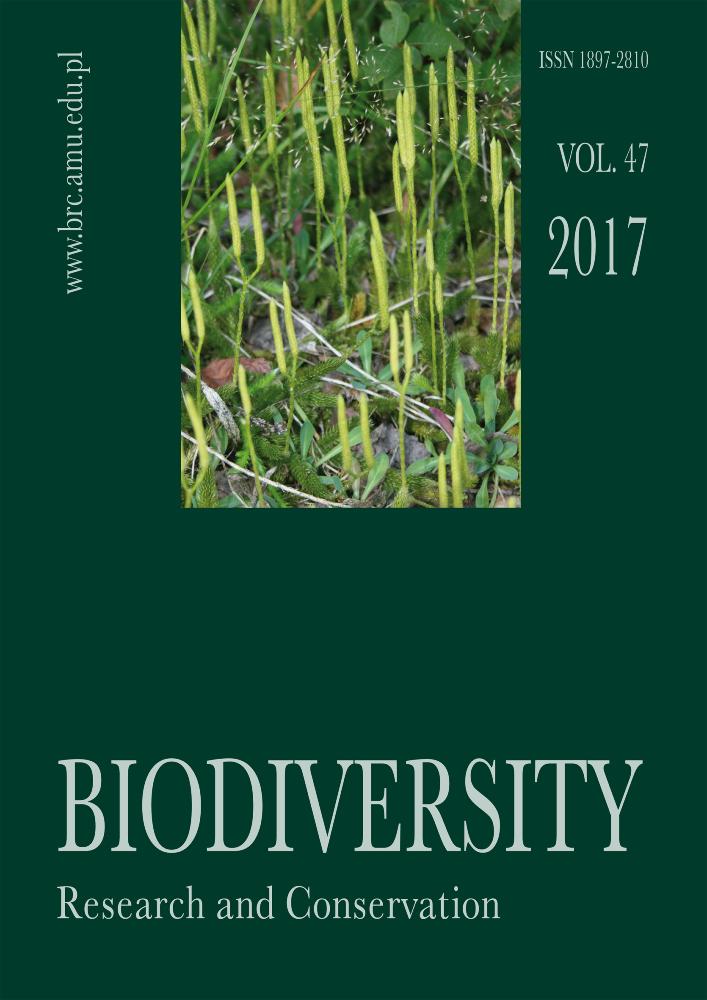Abstract
Vegetation of Isoëto-Nano-Juncetea class has been investigated in the Sluch River valley within the forest-steppe zone. We distinguished three associations belonging to Verbenion supinae (Pulicario vulgaris-Menthetum pulegii Slavnić 1951), Eleocharition ovatae (Cyperetum micheliani Horvatić 1931 and Veronico anagalloidis-Lythretum hyssopifoliae Wagner ex Holzner 1973) alliances. The floristic composition of these syntaxa, is rich in diagnostic species of Bidentetea tripartitae and Phragmito-Magnocaricetea classes, which could indicate a transition to more sustainable communities in the succession row. Our current work is a small portion of a large task to clarify the location of ‘hot spots’ across the overall diversity of Isoëto-Nano-Juncetea, and to identify where and how this diversity can be maintained best.
References
Brullo S. & Minissale P. 1998. Considerazioni sintassonomiche sulla classe Isoëto-Nanojuncetea. Itinera Geobotanica 11: 263-290.
Chytrý M. 2011. Vegetation of the Czech Republic. Aquatic and wetland vegetation. Vyd. 1: 828.
Chytrý M., Tichý L., Holt J. & Botta-Dukát Z. 2002. Determination of diagnostic species with statistical fidelity measures. J Veg Sci 13: 79-90. https://doi.org/10.1111/j.1654-1103.2002.tb02025.x
Hennekens S. M. & Schaminée J. H. J. 2001. TURBOVEG, a comprehensive data base management system for vegetation data. J Veg Sci. 12(4): 589-591. http://dx.doi.org/10.2307/3237010
Holub V. B., Dubyna D. V. & Kuz'myna E. V. 2007. Communities of Eragrostidetum suaveolentis ass. nova in the valley of the Lower Volga. Samara Bend. 16 (3) (21): 532-537.
Kovalenko O. 2014. Syntaxonomy of food-plain ephemerous vegetation (Isoëto-Nano-Juncetea of the National Nature Park “Pyryatynsky” (Poltava region, Ukraine). Botanical Journal 99(1): 34-60.
Krawczyk R., Cwener A., Michalczuk W. & Zubel R. 2016. Ephemeral wetland communities of Isoëto-Nano-Juncetea class – new data from south-eastern Poland. Biodiv. Res. Conserv. 42: 41-54. https://doi.org/10.1515/biorc-2016-0007
Mucina L., Bültmann H., Dierssen K., Theurillat J.-P., Raus T., Č arni A., Šumberová K., W illner W., Dengler J., Gavilán García R., Chytrý M., Hájek M., Di Pietro R., I akushenko D., Pallas J., Daniëls F. J. A., Bergmeier F. E., Santos Guerra A., Ermakov N., Valachovič M., Schaminée J. H. J., Lysenko T., Didukh Ya. P., Pignatti S., Rodwell J. S., Capelo J., Weber H. E., Solomeshch A., Dimopoulos P., Aguiar C., Hennekens S. M., Tichý L. 2016. Vegetation of Europe: hierarchical foristic classification system of vascular plant, bryophyte, lichen, and algal communities. App Veg Sci, 19(Suppl. 1): 3-264.
Orlov O. O. & Yakushenko D. M. 2005. Vegetation of the projected Korostyshevsky National Park. 180 pp.
Popiela A., Prajs B. & Łysko A. 2009. New data on the distribution of dwarf ephemeral wetland vascular plant species and communities in western and north-western Poland. Biodiv. Res. Conserv. 15: 41-46. DOI: https://doi.org/10.2478/v10119-009-0016-0
Pyankov V.I., Ziegler H., Akhani H., Deigele C. & Lüttge U. 2010. European plants with C4 photosynthesis: geographical and taxonomic distribution and relations to climate parameters. Bot J Linn Soc 163(3): 283-304.
Semenyshchenkov Yu. A. 2009. Phytocenotic diversity of Sudost-Desnyanskogo interfuves, pp. 68-70.
Senchylo O. O. & Honcharenko I. V. 2008. Isoëto-Nano-Juncetea of the limitation bare of the steppe zone Dnipro. Bulletin of Donetsk National University, Series A: Natural sciences 2: 334-343.
Simpson M. G. 2010. Plant Systematics, 2nd Edition. 752 pp. Academic Press.
Solomakha V. A. 2008. Syntaksonomiia roslynnosti Ukrajiny. Tretie nablyzhennia. 296 pp. Fitosociocentr, Kyiv.
Šumberová K. & Hrivnák R. 2013. Formalised classification of the annual herb vegetation of wetlands (Isoëto-Nano-Juncetea class) in the Czech Republic and Slovakia (Central Europe). Phytocoenologia 43 (1-2): 13-40. DOI: https://doi.org/10.1127/0340-269X/2013/0043-0529
Taran H. S. 1995. A little known vegetation class of the former USSR – food-plain Ephemeretum (Isoëto-Nanojuncetea Br.-Bl. et Tx. 43). Siberian Journal of Ecology 2(4): 372-380.
Taran H. S. 2001. Association Cypero-Limoselletum (Oberd. 1957) Korneck 1960 (Isoëto-Nano-Juncetea) in the floodplain of middle Ob. Vegetation of Russia 1: 43-56.
Taran H. S. 2009. Bottomland ephemeretum of Ob and Irtysh Rivers near Khanty-Mansiysk city. Vestnik of the Orenburg State University. 2: 108-110.
Taran H. S. 2017. Ephemeral Wetland Vegetation of the Ob River in the Forest-Steppe Zone of Western Siberia. Journal of Siberian Federal University. Biology, p. 1-17. DOI: 10.17516/1997-1389-0032
Tichý L. 2002. JUICE, software for vegetation classification. J Veg Sci 13: 451-453.
License
Copyright (c) 2017 Inna Korotka, Nataliia Pashkevych

This work is licensed under a Creative Commons Attribution-NonCommercial-NoDerivatives 4.0 International License.




